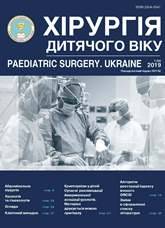Features treatment of children with congenital ureteral pathology
DOI:
https://doi.org/10.15574/PS.2019.64.22Keywords:
children, megaureter bladder-ureteral reflux, treatmentAbstract
The manifestation variety and the high prevalence of the ureteral pathology, the severity of the resulting complications requires early diagnosis and determination of treatment tactics.The purpose of the research is to provide the comparative assessments of the treatment results of children with the ureteral pathology and to define the criteria of the treatment efficiency.
Materials and methods. Pathology of the ureter is determined by constant changes in the ureter wall and the impairment of the ureter contractive ability. Screening in diagnostics is the ultrasound of kidneys and the urinary bladder with the diuretic load and Doppler of kidney vessels, intravenous ureography. The gold standard in diagnostics of a refluxing megaureter and vesicoureteric reflux (VUR) is voiding cystourethrogram (VCUG).
Results. One thousand sixty two patients with the different degree of ureteral reflux were treated in the regional children clinical hospital of Dnipro city. They were between the ages of 3 months to 17 years. An examination revealed that 118 children had a severe congenital defect – refluxing megaureter and 624 patients had third-degree VUR. The performed treatment of children with refluxing megaureter along a big size bladder diverticulum (bladder ears) appeared to have been difficult. Extravesical plastic method was used for the treatment. Also endoscopic gel delivery was used during the treatment of children with the refluxing megaureter complicated by the constantly arising pyelonephritis when the inefficiency of minimally invasive methods of treatment appeared. A positive result was achieved in 67.7% of cases. Intravesical plastic was performed for the rest of children. The analysis of treatment was done for 844 children with the different degree of VUR. The positive result was achieved in 211 children with VUR of I-III degree when no evident inflammatory response was manifested. Endoscopic plastic of the uretero-vesicular segment (UVS) was performed on 551 children aged from 6 months to 17 years. A positive result was obtained in 87.3% of cases. In the absence of the effect of the performed treatment, the surgery was performed in 82 patients with the effectiveness of 96.3%
Conclusions. When treating children with congenital refluxing megaureter in the early stages of treatment, preference should be given to conservative and minimally invasive treatment methods. The age of the child and the functional ability of the bladder are important in determining the terms of reconstructive surgery. The criterion for the choice of surgical intervention is defined by the presence of the pathology factors. Extravesical plastic is used more often. The use of nonoperative, minimally invasive and endoscopic treatment methods in the selection of an approach to the treatment of VUR are prioritized and reasonable.
No conflict of interest was declared by the authors.
References
Vozianov OF, Sejmivs`ky`j DA, Blixar VE. (2000). Congenital urinary tract defects in children Ternopil: Ukrmedknig: 51-93.
Grona VN, Malcev VN, Shherbynyn AA, Shherbynyn AV. (2007). Diagnosis megaureter and bladder-ureter reflux in young children. Health baby. 3: 93-96.
Dmytryakov VA, Gerashhenko YuP, Zaporozhchenko AG, Velykanov VV. (2003). Disproportion growth and maturation in the formation of bladder dysfunction in children. Zaporozhye medical journal. 2-3: 77-81.
Lopatkyn NA, Pugachev AG, Kudryavcev YuV. (2002). Pathogenetic bases and choice of treatment vesicoureteral reflux in children. Urology. 1: 47-50.
Moskalenko VZ, Mal`cev VN, Shherbynyn AA, Shherbynyn AV. (2004). To the question of tactics and treatment of malformations the terminal department of the ureter in children. Paediatric Surgery. Ukraine. 1; 3: 118-123.
Nakonechnyy RA, Prytula VP, Nakonechnyі AІ. (2017). Complication of intravesical correction of vesicoureteral reflux in children. Paediatric Surgery. Ukraine. 4 (57): 72-80. https://doi.org/10.15574/PS.2017.57.72
Nakonechnyj RA. (2015). Efficacy of mini-invasive treatment of the bladder reflux in children. Urology.19;3.
Sejmivskyj DA, Kalishhuk OA, Peterburzkyj VF. (2005). Opportunity assessment endoscopic correction of bladderurinary reflux according to long-term data results. Pediatric Surgery. 1: 25-28.
Solovjov AYe, Dmy`tryakov BO, Zaporozhchenko AG, Baruxovych VYa et al. (2005). Dosvid endoskopichnoho likuvannya mikhurovo-sechovidnoho reflyuksa u ditey. Pratsi naukovo-praktychnoyi konferentsiyi dytyachykh urolohiv Ukrayiny. L.viv-Kyiv: 23-25.
Solovjov AYe, Dmytryakov BO, Zaporozhchenko AG. (2003). Ultrasonographic criteria bladder-urinary reflux in children. Urology. 7;2: 37-39.
Downloads
Issue
Section
License
The policy of the Journal “PAEDIATRIC SURGERY. UKRAINE” is compatible with the vast majority of funders' of open access and self-archiving policies. The journal provides immediate open access route being convinced that everyone – not only scientists - can benefit from research results, and publishes articles exclusively under open access distribution, with a Creative Commons Attribution-Noncommercial 4.0 international license(СС BY-NC).
Authors transfer the copyright to the Journal “PAEDIATRIC SURGERY.UKRAINE” when the manuscript is accepted for publication. Authors declare that this manuscript has not been published nor is under simultaneous consideration for publication elsewhere. After publication, the articles become freely available on-line to the public.
Readers have the right to use, distribute, and reproduce articles in any medium, provided the articles and the journal are properly cited.
The use of published materials for commercial purposes is strongly prohibited.

